University IT Infrastructure Management Report - Analysis & Insights
VerifiedAdded on 2022/10/12
|9
|1422
|64
Report
AI Summary
This report delves into the multifaceted realm of IT infrastructure management, providing a comprehensive overview of key concepts such as competitive advantages, data discovery, data marts, text analytics and mining, business continuity, and electronic records management. It further explores current sustainability issues within the IT industry, including high pollution, waste disposal, climate change, and inadequate water access. The report also addresses the impact of cyber threats, discussing main types of threats, defense mechanisms, challenges posed by Advanced Persistent Threats (APTs), and the effectiveness of the Defense in Depth (DiD) model in mitigating these risks. The report uses a well-structured format to analyze these topics, providing definitions, examples, and references to support the information provided.
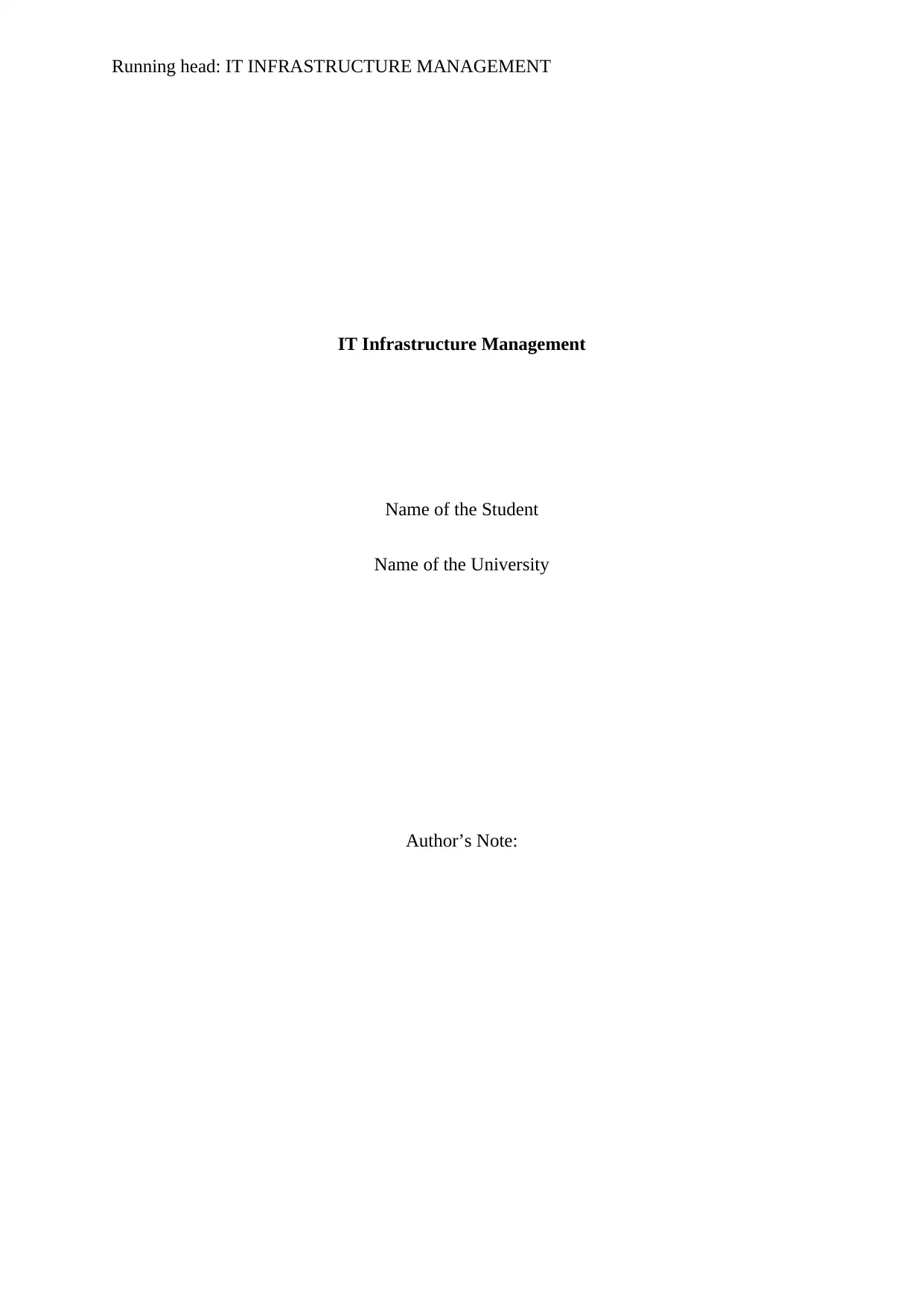
Running head: IT INFRASTRUCTURE MANAGEMENT
IT Infrastructure Management
Name of the Student
Name of the University
Author’s Note:
IT Infrastructure Management
Name of the Student
Name of the University
Author’s Note:
Paraphrase This Document
Need a fresh take? Get an instant paraphrase of this document with our AI Paraphraser
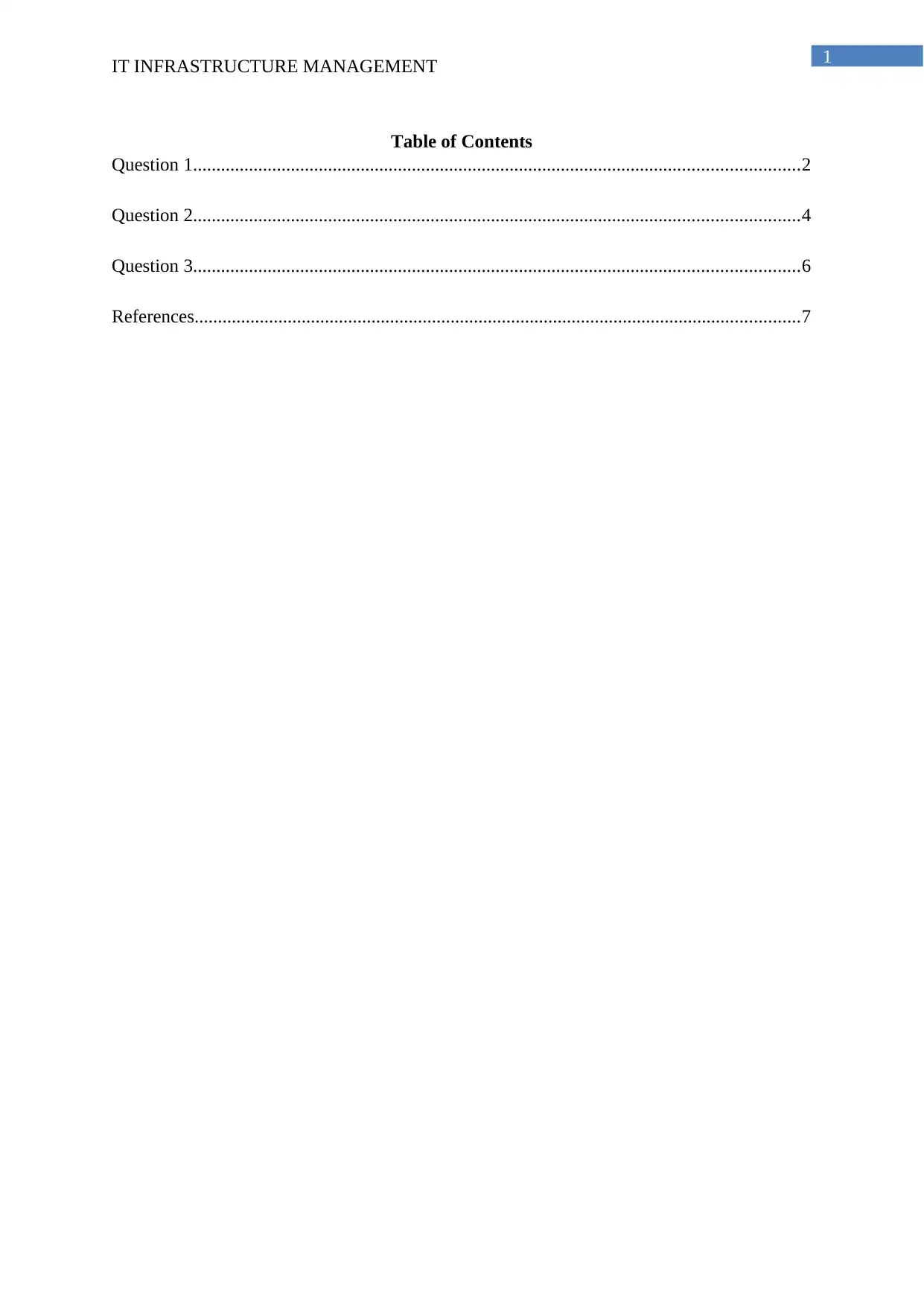
1
IT INFRASTRUCTURE MANAGEMENT
Table of Contents
Question 1..................................................................................................................................2
Question 2..................................................................................................................................4
Question 3..................................................................................................................................6
References..................................................................................................................................7
IT INFRASTRUCTURE MANAGEMENT
Table of Contents
Question 1..................................................................................................................................2
Question 2..................................................................................................................................4
Question 3..................................................................................................................................6
References..................................................................................................................................7
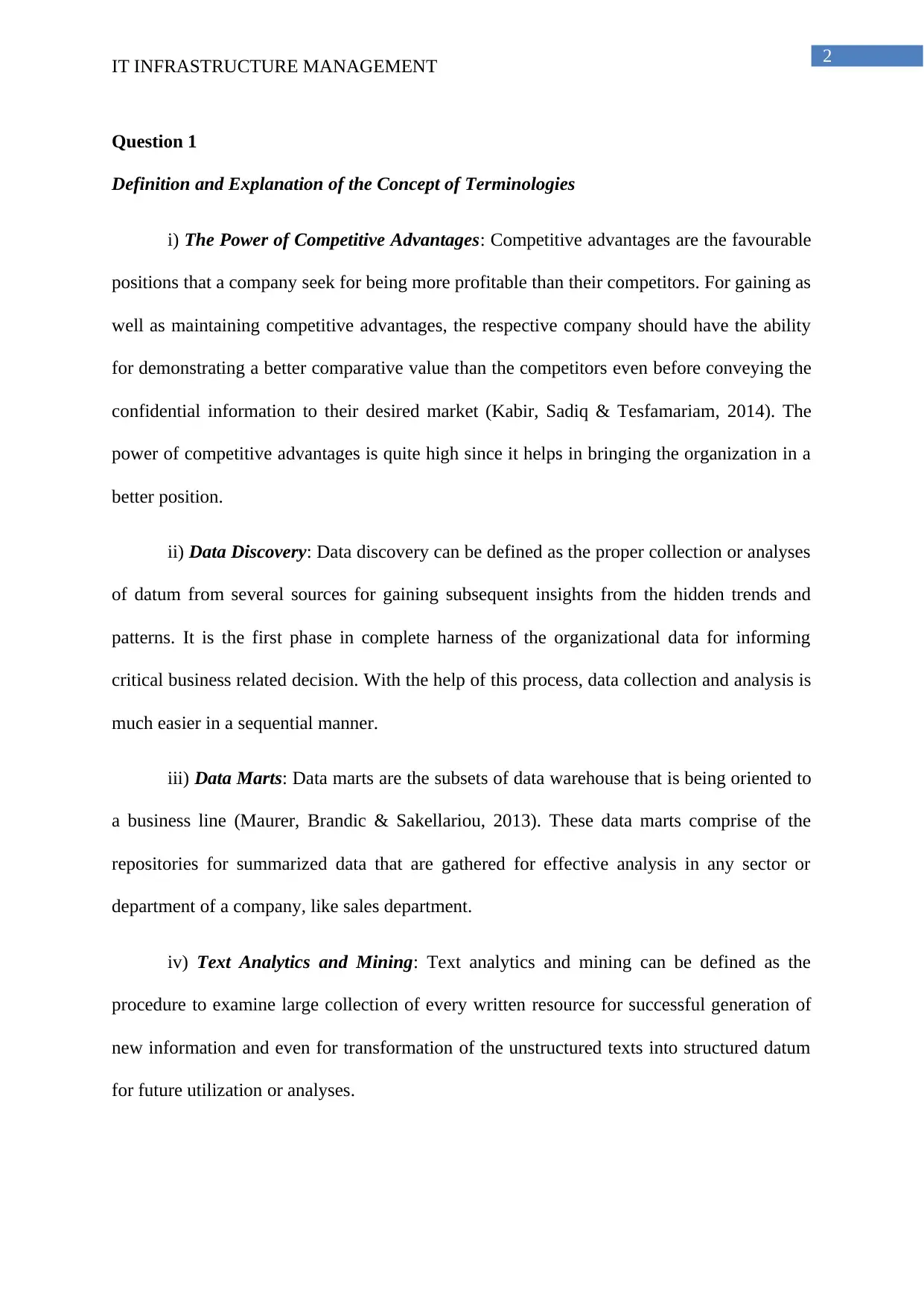
2
IT INFRASTRUCTURE MANAGEMENT
Question 1
Definition and Explanation of the Concept of Terminologies
i) The Power of Competitive Advantages: Competitive advantages are the favourable
positions that a company seek for being more profitable than their competitors. For gaining as
well as maintaining competitive advantages, the respective company should have the ability
for demonstrating a better comparative value than the competitors even before conveying the
confidential information to their desired market (Kabir, Sadiq & Tesfamariam, 2014). The
power of competitive advantages is quite high since it helps in bringing the organization in a
better position.
ii) Data Discovery: Data discovery can be defined as the proper collection or analyses
of datum from several sources for gaining subsequent insights from the hidden trends and
patterns. It is the first phase in complete harness of the organizational data for informing
critical business related decision. With the help of this process, data collection and analysis is
much easier in a sequential manner.
iii) Data Marts: Data marts are the subsets of data warehouse that is being oriented to
a business line (Maurer, Brandic & Sakellariou, 2013). These data marts comprise of the
repositories for summarized data that are gathered for effective analysis in any sector or
department of a company, like sales department.
iv) Text Analytics and Mining: Text analytics and mining can be defined as the
procedure to examine large collection of every written resource for successful generation of
new information and even for transformation of the unstructured texts into structured datum
for future utilization or analyses.
IT INFRASTRUCTURE MANAGEMENT
Question 1
Definition and Explanation of the Concept of Terminologies
i) The Power of Competitive Advantages: Competitive advantages are the favourable
positions that a company seek for being more profitable than their competitors. For gaining as
well as maintaining competitive advantages, the respective company should have the ability
for demonstrating a better comparative value than the competitors even before conveying the
confidential information to their desired market (Kabir, Sadiq & Tesfamariam, 2014). The
power of competitive advantages is quite high since it helps in bringing the organization in a
better position.
ii) Data Discovery: Data discovery can be defined as the proper collection or analyses
of datum from several sources for gaining subsequent insights from the hidden trends and
patterns. It is the first phase in complete harness of the organizational data for informing
critical business related decision. With the help of this process, data collection and analysis is
much easier in a sequential manner.
iii) Data Marts: Data marts are the subsets of data warehouse that is being oriented to
a business line (Maurer, Brandic & Sakellariou, 2013). These data marts comprise of the
repositories for summarized data that are gathered for effective analysis in any sector or
department of a company, like sales department.
iv) Text Analytics and Mining: Text analytics and mining can be defined as the
procedure to examine large collection of every written resource for successful generation of
new information and even for transformation of the unstructured texts into structured datum
for future utilization or analyses.
⊘ This is a preview!⊘
Do you want full access?
Subscribe today to unlock all pages.

Trusted by 1+ million students worldwide
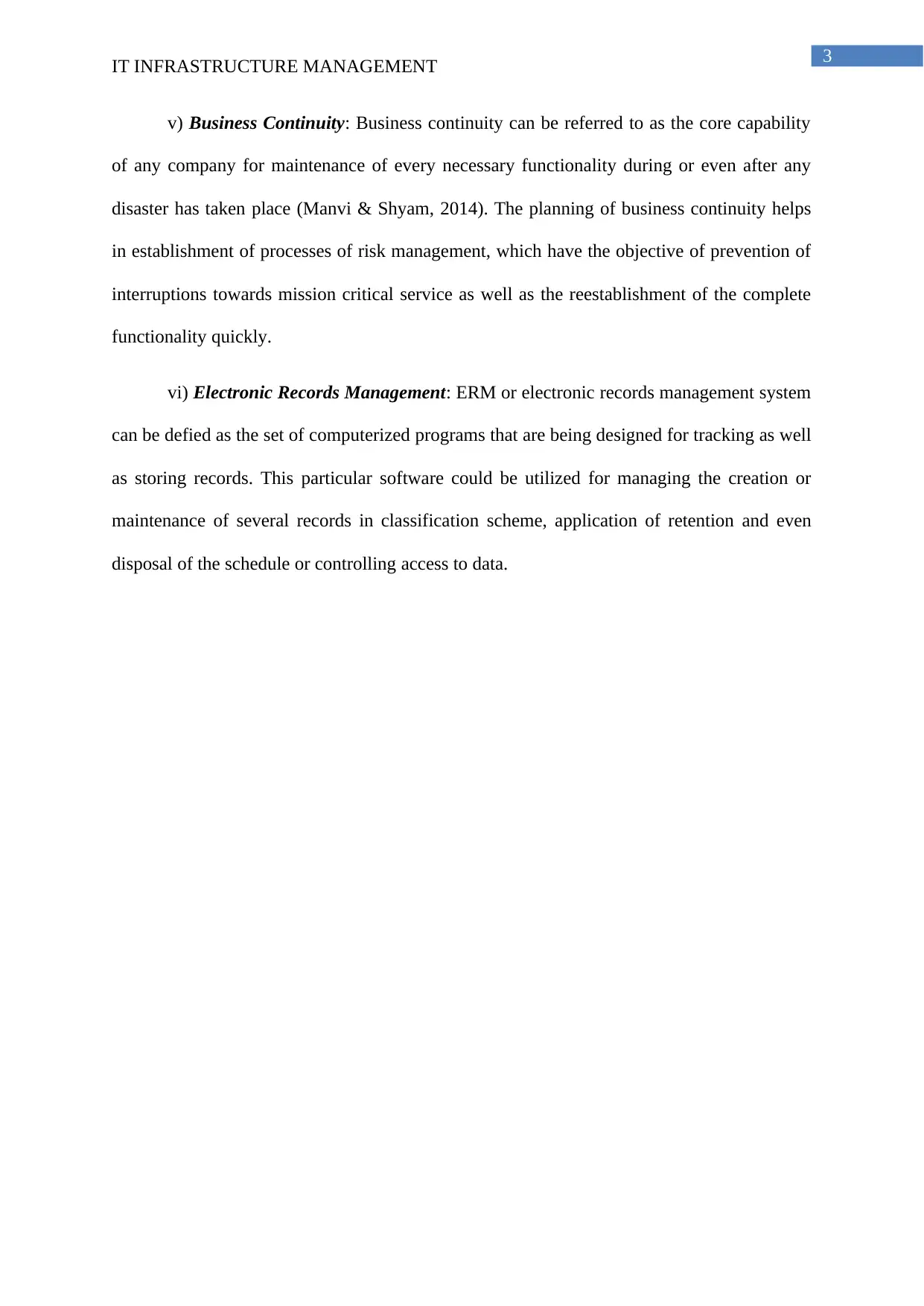
3
IT INFRASTRUCTURE MANAGEMENT
v) Business Continuity: Business continuity can be referred to as the core capability
of any company for maintenance of every necessary functionality during or even after any
disaster has taken place (Manvi & Shyam, 2014). The planning of business continuity helps
in establishment of processes of risk management, which have the objective of prevention of
interruptions towards mission critical service as well as the reestablishment of the complete
functionality quickly.
vi) Electronic Records Management: ERM or electronic records management system
can be defied as the set of computerized programs that are being designed for tracking as well
as storing records. This particular software could be utilized for managing the creation or
maintenance of several records in classification scheme, application of retention and even
disposal of the schedule or controlling access to data.
IT INFRASTRUCTURE MANAGEMENT
v) Business Continuity: Business continuity can be referred to as the core capability
of any company for maintenance of every necessary functionality during or even after any
disaster has taken place (Manvi & Shyam, 2014). The planning of business continuity helps
in establishment of processes of risk management, which have the objective of prevention of
interruptions towards mission critical service as well as the reestablishment of the complete
functionality quickly.
vi) Electronic Records Management: ERM or electronic records management system
can be defied as the set of computerized programs that are being designed for tracking as well
as storing records. This particular software could be utilized for managing the creation or
maintenance of several records in classification scheme, application of retention and even
disposal of the schedule or controlling access to data.
Paraphrase This Document
Need a fresh take? Get an instant paraphrase of this document with our AI Paraphraser
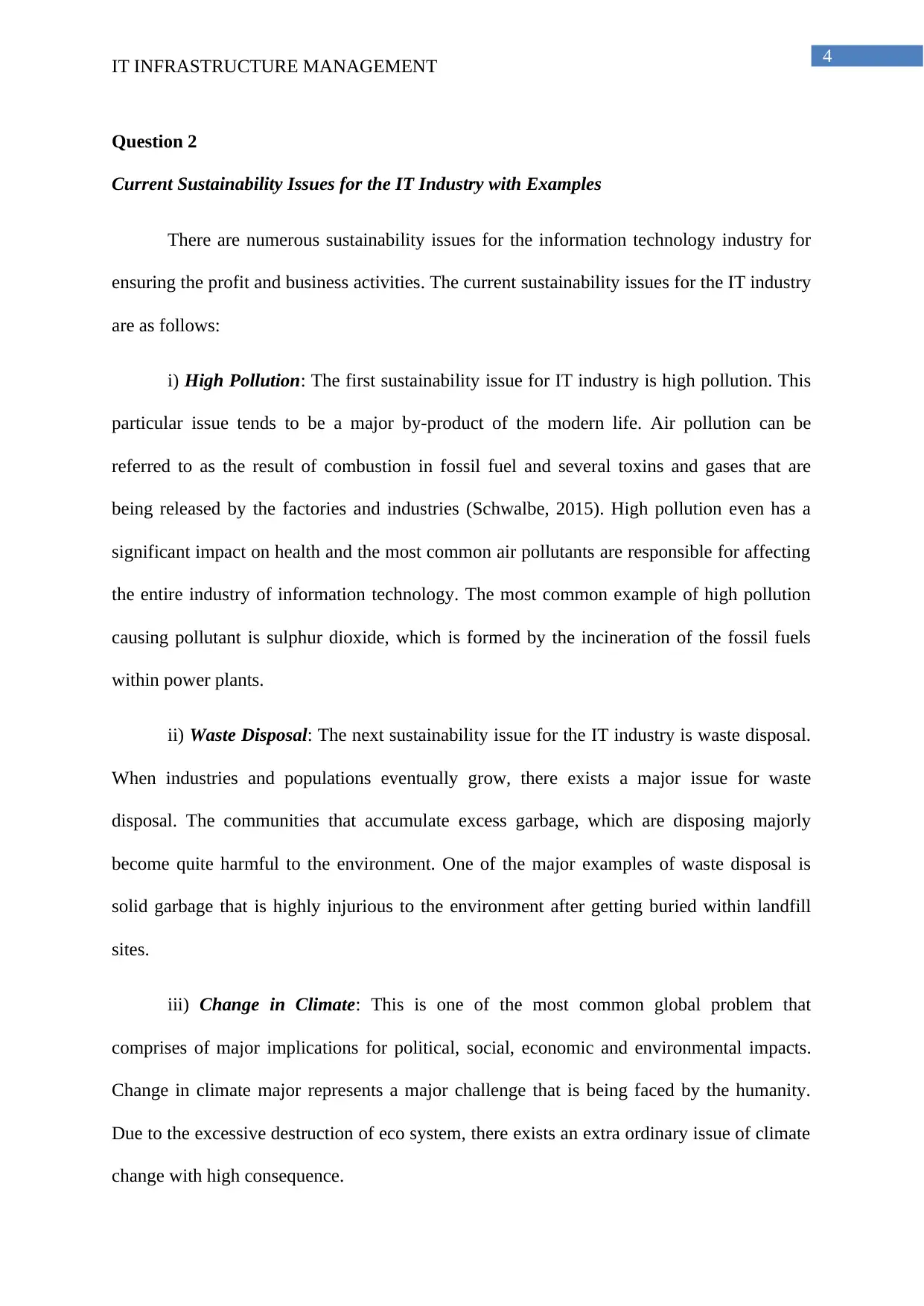
4
IT INFRASTRUCTURE MANAGEMENT
Question 2
Current Sustainability Issues for the IT Industry with Examples
There are numerous sustainability issues for the information technology industry for
ensuring the profit and business activities. The current sustainability issues for the IT industry
are as follows:
i) High Pollution: The first sustainability issue for IT industry is high pollution. This
particular issue tends to be a major by-product of the modern life. Air pollution can be
referred to as the result of combustion in fossil fuel and several toxins and gases that are
being released by the factories and industries (Schwalbe, 2015). High pollution even has a
significant impact on health and the most common air pollutants are responsible for affecting
the entire industry of information technology. The most common example of high pollution
causing pollutant is sulphur dioxide, which is formed by the incineration of the fossil fuels
within power plants.
ii) Waste Disposal: The next sustainability issue for the IT industry is waste disposal.
When industries and populations eventually grow, there exists a major issue for waste
disposal. The communities that accumulate excess garbage, which are disposing majorly
become quite harmful to the environment. One of the major examples of waste disposal is
solid garbage that is highly injurious to the environment after getting buried within landfill
sites.
iii) Change in Climate: This is one of the most common global problem that
comprises of major implications for political, social, economic and environmental impacts.
Change in climate major represents a major challenge that is being faced by the humanity.
Due to the excessive destruction of eco system, there exists an extra ordinary issue of climate
change with high consequence.
IT INFRASTRUCTURE MANAGEMENT
Question 2
Current Sustainability Issues for the IT Industry with Examples
There are numerous sustainability issues for the information technology industry for
ensuring the profit and business activities. The current sustainability issues for the IT industry
are as follows:
i) High Pollution: The first sustainability issue for IT industry is high pollution. This
particular issue tends to be a major by-product of the modern life. Air pollution can be
referred to as the result of combustion in fossil fuel and several toxins and gases that are
being released by the factories and industries (Schwalbe, 2015). High pollution even has a
significant impact on health and the most common air pollutants are responsible for affecting
the entire industry of information technology. The most common example of high pollution
causing pollutant is sulphur dioxide, which is formed by the incineration of the fossil fuels
within power plants.
ii) Waste Disposal: The next sustainability issue for the IT industry is waste disposal.
When industries and populations eventually grow, there exists a major issue for waste
disposal. The communities that accumulate excess garbage, which are disposing majorly
become quite harmful to the environment. One of the major examples of waste disposal is
solid garbage that is highly injurious to the environment after getting buried within landfill
sites.
iii) Change in Climate: This is one of the most common global problem that
comprises of major implications for political, social, economic and environmental impacts.
Change in climate major represents a major challenge that is being faced by the humanity.
Due to the excessive destruction of eco system, there exists an extra ordinary issue of climate
change with high consequence.
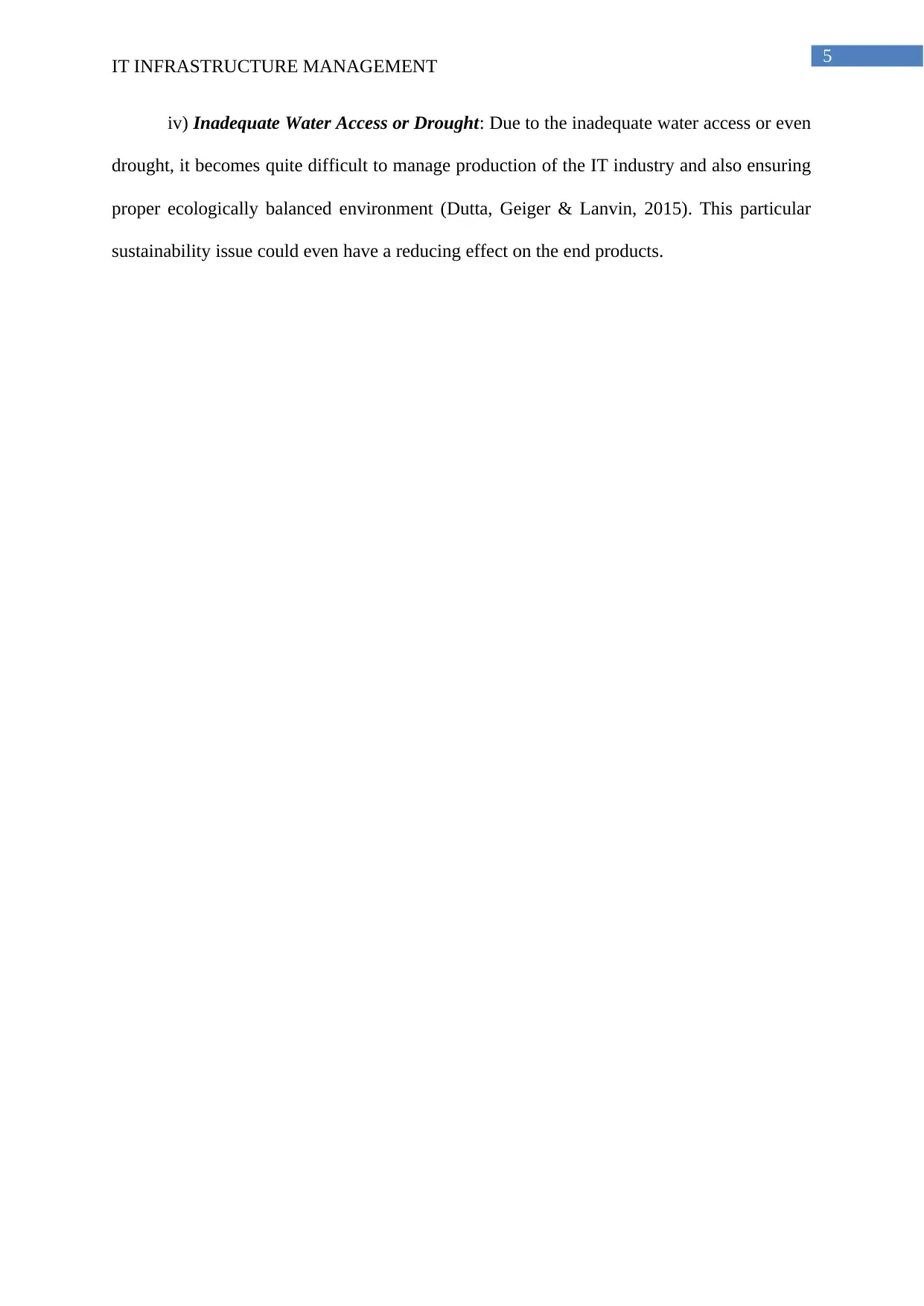
5
IT INFRASTRUCTURE MANAGEMENT
iv) Inadequate Water Access or Drought: Due to the inadequate water access or even
drought, it becomes quite difficult to manage production of the IT industry and also ensuring
proper ecologically balanced environment (Dutta, Geiger & Lanvin, 2015). This particular
sustainability issue could even have a reducing effect on the end products.
IT INFRASTRUCTURE MANAGEMENT
iv) Inadequate Water Access or Drought: Due to the inadequate water access or even
drought, it becomes quite difficult to manage production of the IT industry and also ensuring
proper ecologically balanced environment (Dutta, Geiger & Lanvin, 2015). This particular
sustainability issue could even have a reducing effect on the end products.
⊘ This is a preview!⊘
Do you want full access?
Subscribe today to unlock all pages.

Trusted by 1+ million students worldwide
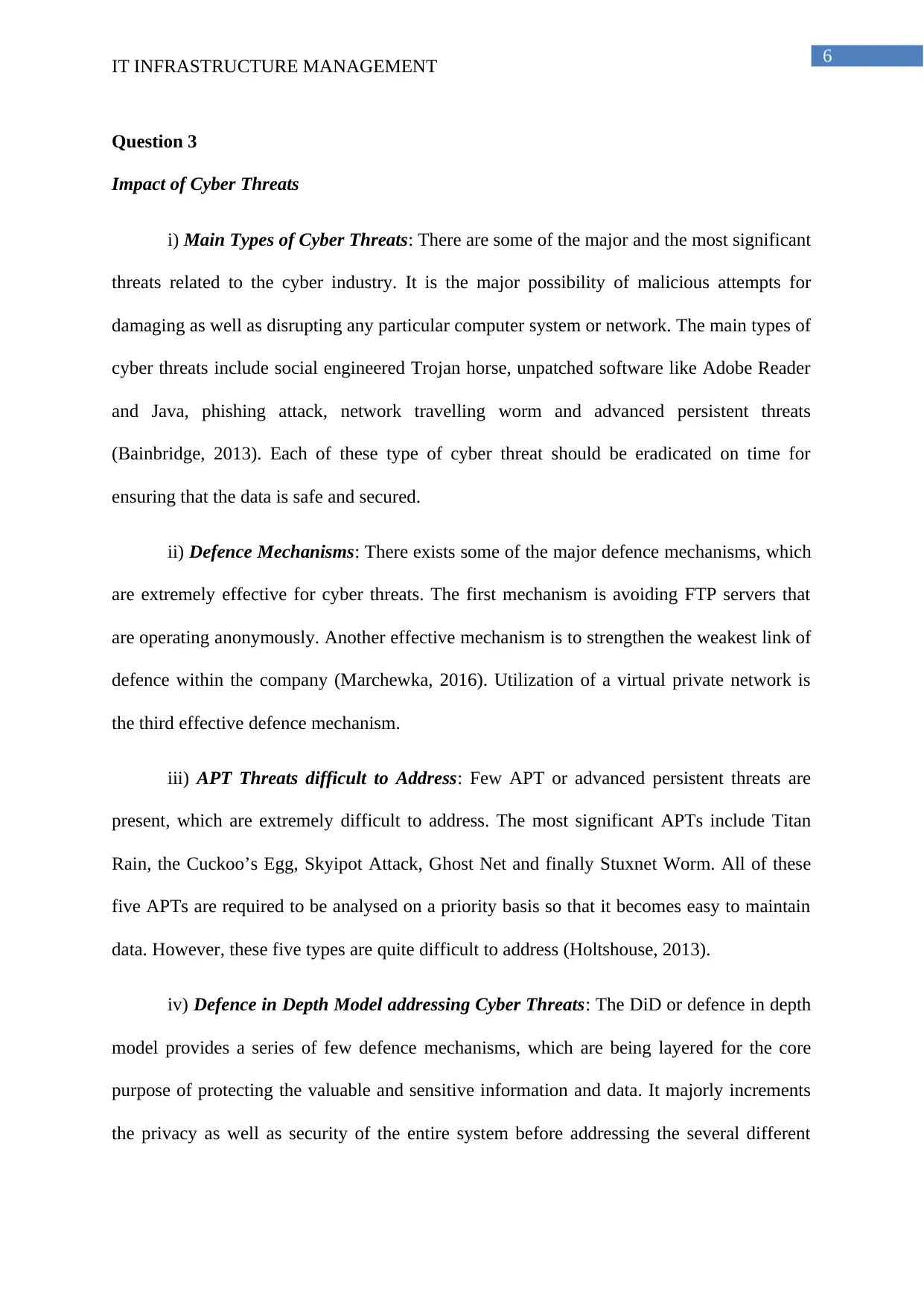
6
IT INFRASTRUCTURE MANAGEMENT
Question 3
Impact of Cyber Threats
i) Main Types of Cyber Threats: There are some of the major and the most significant
threats related to the cyber industry. It is the major possibility of malicious attempts for
damaging as well as disrupting any particular computer system or network. The main types of
cyber threats include social engineered Trojan horse, unpatched software like Adobe Reader
and Java, phishing attack, network travelling worm and advanced persistent threats
(Bainbridge, 2013). Each of these type of cyber threat should be eradicated on time for
ensuring that the data is safe and secured.
ii) Defence Mechanisms: There exists some of the major defence mechanisms, which
are extremely effective for cyber threats. The first mechanism is avoiding FTP servers that
are operating anonymously. Another effective mechanism is to strengthen the weakest link of
defence within the company (Marchewka, 2016). Utilization of a virtual private network is
the third effective defence mechanism.
iii) APT Threats difficult to Address: Few APT or advanced persistent threats are
present, which are extremely difficult to address. The most significant APTs include Titan
Rain, the Cuckoo’s Egg, Skyipot Attack, Ghost Net and finally Stuxnet Worm. All of these
five APTs are required to be analysed on a priority basis so that it becomes easy to maintain
data. However, these five types are quite difficult to address (Holtshouse, 2013).
iv) Defence in Depth Model addressing Cyber Threats: The DiD or defence in depth
model provides a series of few defence mechanisms, which are being layered for the core
purpose of protecting the valuable and sensitive information and data. It majorly increments
the privacy as well as security of the entire system before addressing the several different
IT INFRASTRUCTURE MANAGEMENT
Question 3
Impact of Cyber Threats
i) Main Types of Cyber Threats: There are some of the major and the most significant
threats related to the cyber industry. It is the major possibility of malicious attempts for
damaging as well as disrupting any particular computer system or network. The main types of
cyber threats include social engineered Trojan horse, unpatched software like Adobe Reader
and Java, phishing attack, network travelling worm and advanced persistent threats
(Bainbridge, 2013). Each of these type of cyber threat should be eradicated on time for
ensuring that the data is safe and secured.
ii) Defence Mechanisms: There exists some of the major defence mechanisms, which
are extremely effective for cyber threats. The first mechanism is avoiding FTP servers that
are operating anonymously. Another effective mechanism is to strengthen the weakest link of
defence within the company (Marchewka, 2016). Utilization of a virtual private network is
the third effective defence mechanism.
iii) APT Threats difficult to Address: Few APT or advanced persistent threats are
present, which are extremely difficult to address. The most significant APTs include Titan
Rain, the Cuckoo’s Egg, Skyipot Attack, Ghost Net and finally Stuxnet Worm. All of these
five APTs are required to be analysed on a priority basis so that it becomes easy to maintain
data. However, these five types are quite difficult to address (Holtshouse, 2013).
iv) Defence in Depth Model addressing Cyber Threats: The DiD or defence in depth
model provides a series of few defence mechanisms, which are being layered for the core
purpose of protecting the valuable and sensitive information and data. It majorly increments
the privacy as well as security of the entire system before addressing the several different
Paraphrase This Document
Need a fresh take? Get an instant paraphrase of this document with our AI Paraphraser
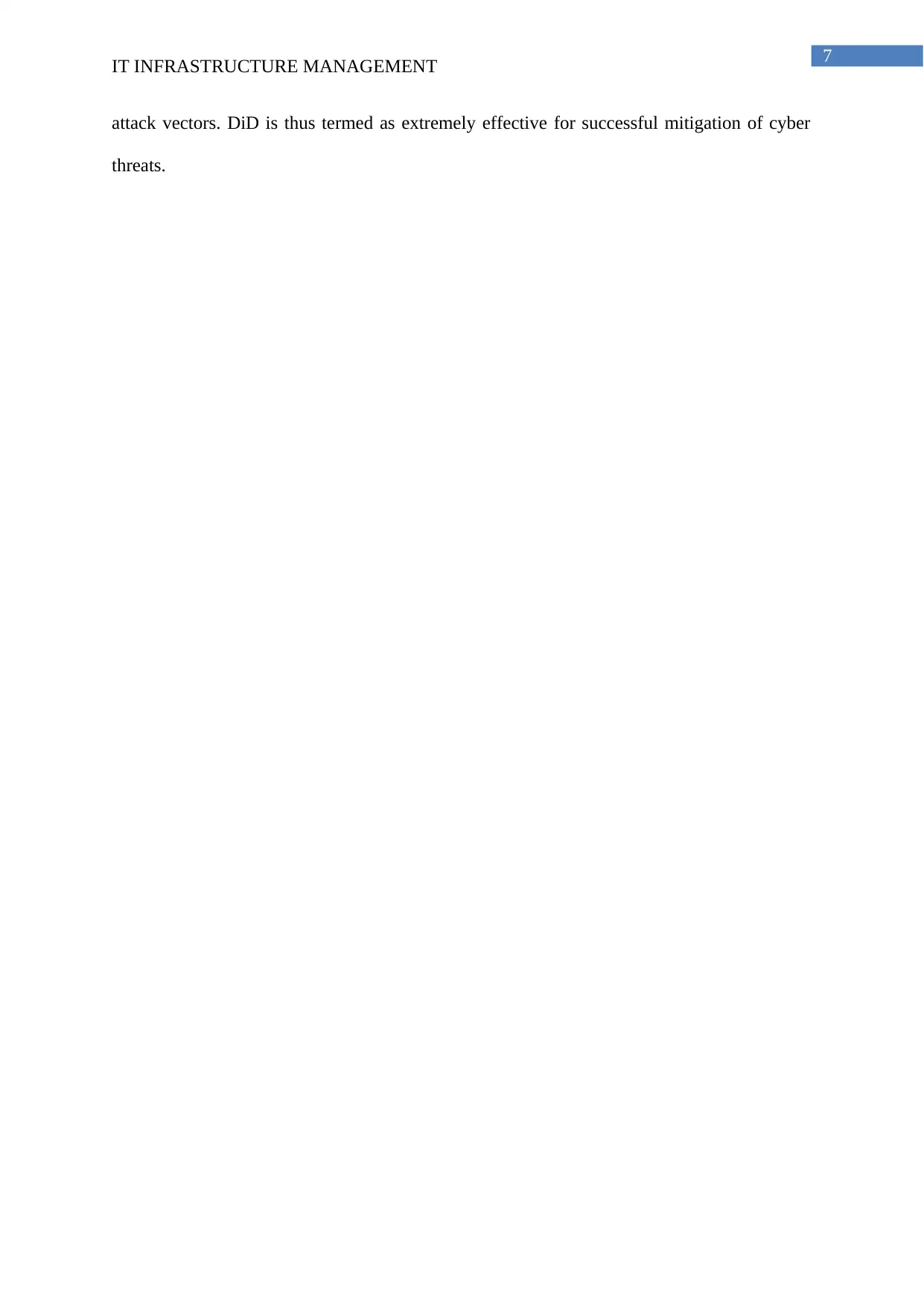
7
IT INFRASTRUCTURE MANAGEMENT
attack vectors. DiD is thus termed as extremely effective for successful mitigation of cyber
threats.
IT INFRASTRUCTURE MANAGEMENT
attack vectors. DiD is thus termed as extremely effective for successful mitigation of cyber
threats.

8
IT INFRASTRUCTURE MANAGEMENT
References
Bainbridge, W. S. (Ed.). (2013). Converging technologies for improving human
performance: Nanotechnology, biotechnology, information technology and cognitive
science. Springer Science & Business Media.
Dutta, S., Geiger, T., & Lanvin, B. (2015). The global information technology report 2015.
In World Economic Forum(Vol. 1, No. 1, pp. P80-85).
Holtshouse, D. K. (2013). Information technology for knowledge management. Springer
Science & Business Media.
Kabir, G., Sadiq, R., & Tesfamariam, S. (2014). A review of multi-criteria decision-making
methods for infrastructure management. Structure and Infrastructure
Engineering, 10(9), 1176-1210.
Manvi, S. S., & Shyam, G. K. (2014). Resource management for Infrastructure as a Service
(IaaS) in cloud computing: A survey. Journal of network and computer
applications, 41, 424-440.
Marchewka, J. T. (2016). Information technology project management: Providing
measurable organizational value. John Wiley & Sons.
Maurer, M., Brandic, I., & Sakellariou, R. (2013). Adaptive resource configuration for cloud
infrastructure management. Future Generation Computer Systems, 29(2), 472-487.
Schwalbe, K. (2015). Information technology project management. Cengage Learning.
IT INFRASTRUCTURE MANAGEMENT
References
Bainbridge, W. S. (Ed.). (2013). Converging technologies for improving human
performance: Nanotechnology, biotechnology, information technology and cognitive
science. Springer Science & Business Media.
Dutta, S., Geiger, T., & Lanvin, B. (2015). The global information technology report 2015.
In World Economic Forum(Vol. 1, No. 1, pp. P80-85).
Holtshouse, D. K. (2013). Information technology for knowledge management. Springer
Science & Business Media.
Kabir, G., Sadiq, R., & Tesfamariam, S. (2014). A review of multi-criteria decision-making
methods for infrastructure management. Structure and Infrastructure
Engineering, 10(9), 1176-1210.
Manvi, S. S., & Shyam, G. K. (2014). Resource management for Infrastructure as a Service
(IaaS) in cloud computing: A survey. Journal of network and computer
applications, 41, 424-440.
Marchewka, J. T. (2016). Information technology project management: Providing
measurable organizational value. John Wiley & Sons.
Maurer, M., Brandic, I., & Sakellariou, R. (2013). Adaptive resource configuration for cloud
infrastructure management. Future Generation Computer Systems, 29(2), 472-487.
Schwalbe, K. (2015). Information technology project management. Cengage Learning.
⊘ This is a preview!⊘
Do you want full access?
Subscribe today to unlock all pages.

Trusted by 1+ million students worldwide
1 out of 9
Related Documents
Your All-in-One AI-Powered Toolkit for Academic Success.
+13062052269
info@desklib.com
Available 24*7 on WhatsApp / Email
![[object Object]](/_next/static/media/star-bottom.7253800d.svg)
Unlock your academic potential
Copyright © 2020–2025 A2Z Services. All Rights Reserved. Developed and managed by ZUCOL.



